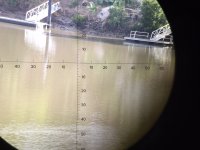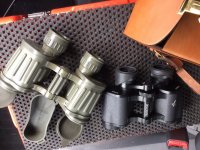My experience with reticles in binoculars has been limited to three (3) models: Zeiss 8x30 IF Safari (roof); Kern 8x30 IF (porro); and Celestron 8x30 IF (roof) in that order.
When Zeiss began to market the Safari in the United States, I bought one for $226 in 1974. At that time I was into all kinds of outdoor adventures, wilderness hiking, canoeing, hunting, X-Cty skiing, etc., and the Safari appeared to be the perfect binocular for me, waterproof, light weight, unbelievably rugged,(I can give personal testimony about the ability of the Safari to take abuse) and good optics.
It wasn't P coated then. That came later in 1988. I might add that P coating IMO is something like Mark Twain commenting on the report that he had died. Twain said, "The report of my death has been greatly exaggerated." I'm willing to take on the naysayers to my comments about P coating. The average bloke couldn't tell the difference or see the difference. Many high quality binoculars (roofs) have been downgraded because the magical word or letter of "P" coating doesn't appear on them. And many of those can be picked up at bargain prices.
Anyway when the Zeiss Safari 8x30 arrived, I was surprised to find it had the reticle in the left barrel. At first I was intrigued by it, but eventually it began to annoy me. It had military application, but after serving in the Marine Corps and Korea, my infatuation with being able to kill my fellow men was on the wane. So I sent it back to Zeiss to be removed. That took several months crossing the Atlantic ocean twice. When it arrived, sans reticle, Zeiss sent the reticle along in a little box. Why? I don't know. Anyone in bird forum land who wants the reticle needs to contact me, and I'll send it to him. Price? Only the postage.
Now this reticle like most is etched on flat glass, meaning that the light transmission is minutely degraded (only the most sophisticated instrument could measure this), but any very tiny speck of dust settling on the surface, will be magnified greatly and that will become very annoying for users tending to be somewhat obsessive, which includes me.
My only knock on the Safari is that the olive colored rubber deteriorates over time and resembles the face of a 70 year old woman who has smoked for 60 of those years. The Japanese clones, particularly those made by Celestron (black rubber) hold up better.
Next came the Kern 8x30 porro IF, It too had the reticle in the left barrel. This Kern model had been rendered obsolete by the newer model with lazer protection. I'm being dogmatic but anything made by the Swiss is very well made, and the Kern was no exception. The lens were made by Leica. It is the toughest porro ever made IMO. Breaking into one to remove the reticle can be a challenge, but not impossible. One must have a very, very sturdy vice and a way to pad the body to avoid damaging it.
An acquaintance made a special wrench for me which works well. The left ocular is unscrewed (counter clockwise) and the reticle housing is carefully tapped out. Great care must be made to avoid gunk going into the inside when doing this, or else something distracting may appear on the focal plane. I have removed of number of these reticles for friends. I don't charge for my services to avoid being responsible for damage which inevitably will occur if you play long enough with these objects.
The removal of the Celeston reticles is easier. An ordinary strap wrench will break the left eye piece loose, and reveal a plate holding the reticle attached by three screws. Remove those and the reticle, and your distraction ceases to exist.
I don't believe the brain accommodates the reticle so you don't see it. It is there. It reminds me of the current run of rifle scopes which I call wart hog scopes, bumps protruding all over the tubes to accommodate some special feature that may pique the imagination but in real use is illusory.
The wart hog phenomenon is sweeping the binocular industry with multi-purpose binoculars which have little practical application to the user. So what if the bird or critter is 296 yards away? Or 102 yards, or 1,020 yards?
Compasses do exist for marine application. But we will probably see GPS and the Apple watch incorporated in some binocular in the future so when the user becomes bored with looking at birds or whatever, they can check with the weather channel or the stock market or his favorite porn site. I better stop this rant.
John






